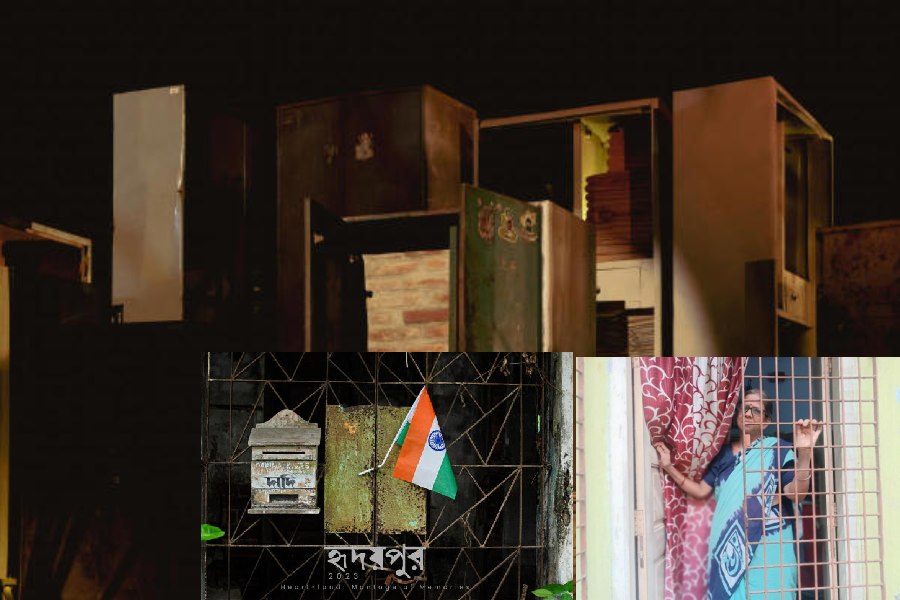Hridaypur might literally translate into heartland but the word “hriday” has a depth that the English “heart” cannot quite convey. Hridaypur, the quaint-sounding compound word, is most likely the name of more than one place scattered across West Bengal. It is the title of a poem by the legendary Shakti Chattopadhyay. And it is the name artist Pradip Das has chosen for his installation.
The installation is a collection of random household items originally used to decorate a Durga Puja pandal, but whose present address is the artist’s studio. The pandal in question was by the Naktala Udayan Sangha Club, and its theme was the journey of East Pakistan refugees who settled down in south Calcutta’s Naktala in the early 1950s.
Hridaypur is part of a trilogy. “The first part, Chalchitra, was made in 2021,” says Das. The second one was Mota Kapod. “I chose a theme local people would be able to relate to. Naktala as we see now, was built brick by brick by the refugees,” he adds.
At a discussion organised recently by the Kolkata Centre of Creativity in collaboration with the Kolkata Partition Museum Trust, Das presented a video of Hridaypur. A spread of photographs, trunks, nameplates, vessels filled with water from the different rivers of Bangladesh, trays with lumps of soil from various parts of Bangladesh. All of it collected by Das himself, neatly labelled, the backstories archived inside Das’s own head. “The installation will be part of the museum by Kolkata Partition Museum Trust,” he says.
Ranjit Bhattacharya is among the many Naktala residents whom Das interviewed for the installation. The octogenarian remembers the day he arrived from Khulna. “That would be March 30, 1950,” he says. He recalls how a neighbour offered him a ruti or roti. He adds, “I had never tasted ruti till that day. This was the beginning of a cultural exchange.”
Dishari Mukherjee, a college professor, interviewed various elderly residents for Das’s Hridaypur project. As she tells it, around the time of Independence this neighbourhood was nothing but a jungle of hogla weeds and paddy fields. Swagata Sarkar, who is another resident, told her, “The place was not called Naktala then. It was referred to as Nagtala as it was full of poisonous snakes.”
The human habitation or colony, as it is referred to in local parlance, came up later. Says Mukherjee, “I have heard stories of how the refugees built their huts by day and the police bulldozed them by night.”
Bhattacharya says, “We were not nameless, penniless people till Partition. I remember our house in Shekharnagar in Dhaka with its orchard, garden and pond teeming with fish.” In Naktala, his father built a hut, a contraption of tin, bamboo and hogla leaves.
Hridaypur captures the stories of other residents. How they lived in the now long forsaken land, how they came to be here. Most of them had fled from places such as Faridpur and Barisal, took boats and arrived at railway junctions such as Khulna.
Sumita Bhattacharya, 65, remembered stories of her parents quaking and praying as police searched the train compartments. When the train finally budged, the women would ululate and blow conches.
Many others would wake up every day and head for Sealdah Station, where they waited for the next batch of refugees in the hope that their near and dear ones would be among them.
“Before 1967, there were no roads here. Bamboo footbridges over wide drains were the only way to get to the local markets, schools and hospitals. Domestic waste was strewn all around,” says Ranjit Bhattacharya. He continues, “I lost my father soon after moving, spent my childhood in abject poverty. I used to borrow textbooks from my classmates.” Bhattacharya went on to become a high court clerk.
These are the kinds of stories Das wanted to build on when he designed the pandal. “I collected commonplace household things from these residents,” says Das whose parents too had left East Pakistan post Partition. Narayan Bhattacharya, 65, gave Das his father’s matriculation certificate, his mother’s Benarasi saree. Dipankar Ghosh Dastidar, 81, shared photographs of his village in Barisal, Dola Chakraborty, 60, who now runs a tea shop, gave him old family pictures, a flower basket made of brass and a silver vermilion box.
“Today, Naktala has no resemblance to what it used to be. There are housing societies, multi-storeyed buildings, pucca roads, proper drainage and whatnot,” says Bhattacharya. Many things that the refugees built are gone, like the Sishu Bharati Vidyamandir primary school and the needlework school.
Das’s installation uses a lot of items in rust. He tells The Telegraph, “I had been criticised for this. But as I see it, I was working with memories in rust.”
